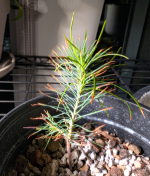tranip
Seed
- Messages
- 3
- Reaction score
- 1
Hello all!
I've been growing a few Austrian pines from seed inspired by the JBP contest.
I've noticed a few of these seedlings have browning tips, some with resin on the browning tips. Any idea what this could be? From what I've seen online it seems like needle blight, but a second opinion would be helpful.
Generally I have them getting 6 hours of direct morning light outdoors (indoors right now for this picture), and they're shaded by a building for the rest of the day. Substrate wise it's a mix of perlite, a clay block and some pumice stone. Watering happens every few days, when I can feel they're fairly dry.
I've also had a JBP seedling with this same expression, however after a few months of doing nothing to it, the new needles look unaffected.

I've been growing a few Austrian pines from seed inspired by the JBP contest.
I've noticed a few of these seedlings have browning tips, some with resin on the browning tips. Any idea what this could be? From what I've seen online it seems like needle blight, but a second opinion would be helpful.
Generally I have them getting 6 hours of direct morning light outdoors (indoors right now for this picture), and they're shaded by a building for the rest of the day. Substrate wise it's a mix of perlite, a clay block and some pumice stone. Watering happens every few days, when I can feel they're fairly dry.
I've also had a JBP seedling with this same expression, however after a few months of doing nothing to it, the new needles look unaffected.

